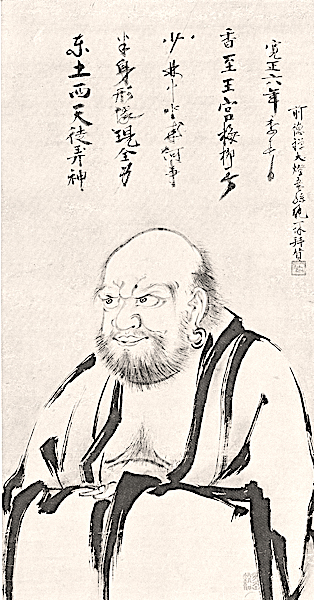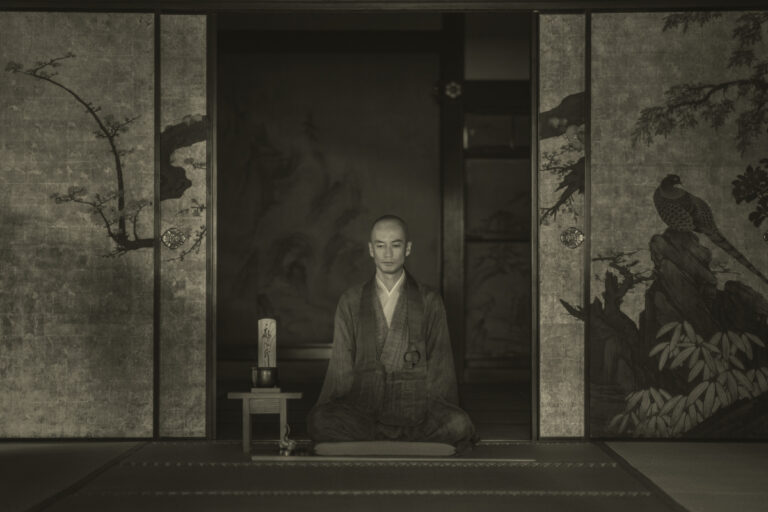Zen

What is Zen?
Zen is an abbreviation for “Zenna,” which is a transliteration of the Sanskrit word meaning to unify the spirit and pursue the truth, and is a term that refers to the Zen sect of practicing zazen. To briefly explain Zen, look for the truth of your own existence. For that reason, Zen monks practice, but Zen can be practiced in everyday life. Control yourself, thank everything, eliminate waste, and rethink your way of life. Such a fundamental thing leads to Zen.
The ancestor of Zen is Bodhidharma. Bodhidharma, who inherited the Buddhist law (correct teaching) that began with Buddha, traveled from India to China in the early 6th century. Bodhidharma Daishi, who has been zazen for nine years at Takayama Shaolin Temple, knows his heart through the direct relationship between his teacher and his disciples, without relying on scriptures, words, or letters, and reaches the state of his enlightenment. Is established.

The teachings were inherited, and the Rinzai sect, Obaku sect, and Soto sect, whose ancestors were Linji Yixuan, were born.
Zen Buddhism was introduced to Japan in earnest from the Kamakura period to the Muromachi period. The Rinzai sect, which was introduced by Eisai over the Southern Song Dynasty, is divided into 14 main temples according to the lineage in China, and the Obaku sect, which was introduced by Ingen during the Edo period, is added. In addition, Dogen introduced the Soto sect, which aims to devote himself to zazen, and 24 schools of Zen sect are currently rooted in Japan. In China, Zen has become unique to Japan since the Ming dynasty.
Steve Jobs devoted himself to "Zen".
Many people think of Zen as Steve Jobs. It’s all too well known that Apple founder Steve Jobs swas devoted to “Zen.” Many people think of Zen as Steve Jobs. It’s all too well known that Apple founder Steve Jobs swas devoted to “Zen.”
He is said to have done no marketing at all. He went down into himself with his meditation and tried to see what he really wanted. Since he makes things that come from his depths, the product may have had the power to shake the depths of his opponent. It would have been his ultimate marketing research to find out what he wanted.
After Jobs’s death, the media suddenly came into the limelight, and the media featured one after another, the Soto Buddhist priest, Kobun Chino Otogawa (born in Niigata Prefecture, 1938-2002), who directed him Zen.
It seems that Zen is the background of Jobs’ manufacturing, which is extremely sophisticated by eliminating impurities. It is said that the black turtleneck of Issey Miyake on jeans might have been Jobs’s Samue (作務衣) with simplicity and functionality.

Breathing meditation Mindfulness
In addition, IT companies that are originally ignorant of new and smart things are all beginning to incorporate Zen into their employee training programs. Those who were drowning in the vast ocean of information seem to have found information and the art of controlling themselves in mindfulness, a sub-stream of Zen and meditation. Google, Intel, IBM, Facebook, and so on, to the US Department of Defense and the US Department of Agriculture.

A new trend of Zen with a stylish image will spread to Europe and the United States under the name of “mindfulness” that eliminates religious colors. And this wave is rushing to Japan, the head of Zen, although it is late.
The word mindfulness is an English translation of the Pali word “sati” used in Buddhist scriptures in Sri Lanka and Myanmar. What is Saty? Awareness of “now and here”. It means that you haven’t gone to the past or the future and are really aware of what you are doing now. It can be translated into keeping in mind, noticing, and being careful.
In other words, it was originally a Buddhist term and is derived from the meditation method used in Theravada Buddhism such as Southeast Asia and Sri Lanka. It was arranged in a form that can be practiced by the general public, mainly in the United States, and its effects were scientifically proven and spread rapidly.
Mindfulness is a religion-free meditation from Buddhist meditation or Theravada meditation.
The method is basically the same as zazen. Close your eyes, correct your posture, and focus on your breathing. When you get confused (distracted and come up with something else), regain consciousness. To put it simply, that’s the case, but it is said that by slowly confronting such thoughts, you will be able to understand the thoughts and thoughts that you need now. It seems that if you master meditation, you will be in a state of nothingness without any confusion. Instead of aiming for nothing from the beginning, try to incorporate meditation as much as you can. Your thoughts are organized.

The point is that there is no need to cross the legs like zazen, eliminating the religious color. Whether it’s 5 or 10 minutes, just observe your breathing and the subtle sensations of your body. It is important to just be aware of it without reacting.
Observe breathing and body sensations
MIT (Massachusetts Institute of Technology) in the United States also has a research institute called “Mindfulness Center”.
Dr. John Kabatzin, its founding director, and Dr. Richard Davidson, a psychiatrist and psychologist, conducted a scientific experiment on mindfulness, and only 7 experiments were conducted by employees of biotechnology companies. Weekly mindfulness training was reported to significantly reduce subjects’ anxiety levels.
Measurement of the subject’s brain activity confirmed a significant increase in brain activity associated with positive emotions. Not only that, but we also found that when subjects were vaccinated against the flu near the end of the study, they produced more antibodies than those who were not trained.

In other words, it was scientifically shown that mindfulness not only made us mentally stable, but also boosted our immune system.
In addition to this, many studies have been conducted on the effects of mindfulness, and many academic papers have been written. And in 2014, the more it was featured in Time magazine, the more attention it has received from the general public.
In Japan as well, the “Japan Society for Mindfulness” was established in 2013, and mindfulness is increasingly being featured in medical and psychological journals. It is already well known that mindfulness is medically effective, and some hospitals are adopting mindfulness as an outpatient treatment.
Mindfulness is separated from the context of religion, as Dr. John Kabat-Zin of MIT explains, “It works without belief.”
Google has several classes to learn and practice mindfulness, but Bill Dwayne, who is the driving force behind this effort at the company, has adopted it so widely because it has lost its religious color. I am analyzing that it has become possible.

However, it originated in Buddhism and is still commonly confused with Buddhist meditation. In Japan, more and more people are interested in zazen because of their mindfulness, and in 2015, it was reported that zazen meditation at temples became more popular than ever. It seems that many people think that Zen and mindfulness are the same thing.
Difference between Zen and Mindfulness
So, is the mindfulness practiced by a well-known global company different from the original Zen? Is it just omitting the religious color? First of all, Zen and mindfulness are the same in meditation, but completely different in nature.
It is good that mindfulness eliminates anxiety and makes the body healthy, and many people are interested in and practice the scientifically proven effect. It will be a chance to think that, so few people will see it negatively.
However, trying to do it because it is effective is the idea of pursuing profits. If you’ve read this far, you might guess, Zen doesn’t take that idea. In other words, the most fundamental motive for meditation and the direction to aim for are completely different from Zen.

For example, when you ask a person who is running what they are running for, there are various answers such as “on a diet”, “because you can refresh”, and “for lack of exercise or for a lifetime”.
That is exactly how mindfulness is used in Europe and the United States. In other words, we do it for some concrete benefit.
However, Zen does not think of such things. Going back to running, we run to run. Or because running itself is comfortable. The purpose is to run itself. Certainly, if you run, you will lose weight and gain strength as a result.
Again, Zen doesn’t aim for that. It just means that it would have happened naturally when I was running. In order to study things, it must be the goal in practice, not the short-circuit benefits in front of us.
In the first place, Buddhism does not believe in any kind of god. It is reported that he said that he was aware that the human being Buddha was enlightened. However, I do not understand the essence of that enlightenment. I don’t know what he has reached.

Therefore, it is the original motive of those who walk Buddhism to know what it is. I don’t know what’s ahead. But believing that there is something, he will be penalized like Buddha. That is the essence of Buddhism and Zen.
Thank you for reading! ありがとう。 Namu Shinnyo ■
















